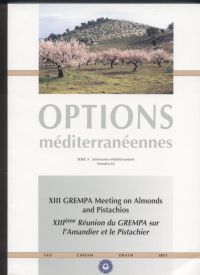| Article précédent | p. 385-389 | Article suivant |
Strategies to introduce resistance to prune dwarf virus in almond
Prune dwarf virus (PDV) and Prunus necrotic ringspot virus (PNRSV) contribute to significant losses in almond productivity, in Portugal and in other countries. The establishment of new orchards with healthy certified trees does not guarantee virus eradication for long periods. Both PDV and PNRSV can be transferred through pollen, making cross-pollination a common source of infection. Genetic engineering using the coat protein (CP) strategy has been a successful method to achieve plant resistance to virus diseases and might be effective to control virus diseases in almond orchards. We prepared several constructs carrying the CP PDV sequence and tested in Agrobacterium-mediated transformation of Nicotiana benthamiana (an easy-to-transform model plant susceptible to PDV). The transgene sequences were placed under the control of the 35S CaMV promoter, inserted in pGREEN vectors (John Innes Centre), with nptII (kanamycin resistance) as a selection marker. With the selected constructs we aim to understand the mechanisms underlying PDV replication in host cells.
- [ Afficher ]
- [ Télécharger ]
- [ Exporter la citation ]
Vous pouvez télécharger la citation au format :
- [ Imprimer ]
-
Mots-clés
PLANTE TRANSGENIQUE, PROTEINE MICROBIENNE, PRUNUS AMYGDALUS, VIRUS DES VEGETAUXCiter cet article
Raquel H., Lourenço T., Moita C., Costa M., Silva S., Oliveira M.M. Strategies to introduce resistance to prune dwarf virus in almond. In : Oliveira M.M. (ed.), Cordeiro V. (ed.). XIII GREMPA Meeting on Almonds and Pistachios . Zaragoza : CIHEAM, 2005. p. 385-389. (Options Méditerranéennes : Série A. Séminaires Méditerranéens; n. 63). 13. Meeting of the Mediterranean Research Group for Almond and Pistachio, 2003/06/01-05, Mirandela (Portugal). http://om.ciheam.org/om/pdf/a63/05600057.pdf



